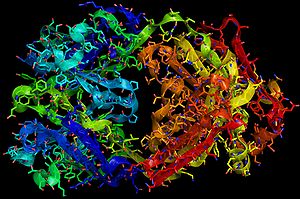Making sense of data – how oncology and cancer is becoming more complex
One of the things many of you may have noticed is how complex the cancer world is becoming. The days of developing broad spectrum chemotherapies that shrink the tumour and blast normal cells as well are gradually going by the wayside. With the advent of increased knowledge about the biology of cancer comes newer, more targeted therapies that not only improve survival, but seemingly reduce the toxic side effects too.
The challenge though, is that cancer remains an elusive beast. With the exception of some specific diseases such as chronic myeloid leukemia (CML), gastro-intestinal stromal tumours (GISTs) and a few others, most cancers appear to have multiple pathways that interact and are critical to survival. This means that ultimately, a combination approach is most likely needed to target the cancer and overcome drug resistance.
 Image via Wikipedia
Image via Wikipedia
The question remains is which combinations are best and in what sequence would be they be most effective?
Although some success has been reported with targeted therapies such as Herceptin (right), Gleevec, Tarceva, Avastin etc, there is still much that we don't know and a lot of science still to be discovered before we can say with any great confidence that we are winning the war on cancer.
This leaves a dilemma for those developing new drugs – which tumours should be targeted, what stage of disease should be researched and what regimens would make the ideal combinations?
R&D is largely an imperfect and inefficient science, but gradually we see a more logical sniper rifle strategy appearing rather than the old fashioned 'let's have a go' blunderbuss approach. That can only be a good thing in the long run but meanwhile, taking a strategic rational analytical approach may well yield solid results.
![Reblog this post [with Zemanta]](http://img.zemanta.com/reblog_e.png?x-id=4b078f04-3794-497e-b9e1-2ff4748e3e01)
One Response to “Making sense of data – how oncology and cancer is becoming more complex”
[…] Making sense of data – how oncology and cancer is becoming more complex This entry was posted in Cancer, Competitive Intelligence, Landscape Opportunity, Market Intelligence, Market Trends, Mechanism of Action, New products, Oncology, Pathways, Pipeline, Strategy, Targeted Therapies and tagged BI 2536, BI2536, competitive intelligence, key opinion leader market research, Pharmaceutical Biotechnology market strategy, PLK-1 inhibitors, portfolio analysis. Bookmark the permalink. ← The value of Twitter for business and competitive intelligence The importance of messaging in new product launches → blog comments powered by Disqus /* […]
Comments are closed.